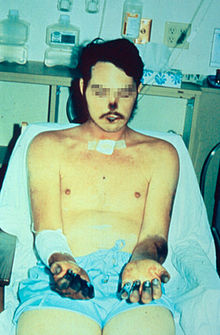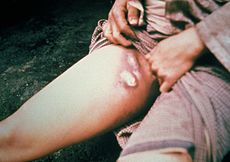Bubonic plague is an infectious disorder that affects many people the world over. Read and know about this most common type of plague and know all about its causes, symptoms, diagnosis and treatment options.
Bubonic plague Definition
Page Contents
- 1 Bubonic plague Definition
- 2 Bubonic plague ICD9 Code
- 3 Bubonic plague Incidence
- 4 Bubonic plague Symptoms
- 5 Bubonic plague Causes
- 6 Is Bubonic plague Contagious?
- 7 Bubonic plague Risk Factors
- 8 Bubonic plague Diagnosis
- 9 Bubonic plague Treatment
- 10 Bubonic plague Prognosis
- 11 Bubonic plague Mortality Rate
- 12 Bubonic plague Complications
- 13 Bubonic plague Prevention
- 14 Bubonic plague Support Groups
- 15 Bubonic plague Pictures
It is a zoonotic disease that is caused when a person is infected by a type of bactetium known as the “Yersinia pestis.” It is characterized by inflamed lymph nodes, historically referred to as “buboes.”
This is believed to be a disease that existed some time in history. However, the condition exists even today. It is known by various other names, like:
- Black plague
- La Peste
- Black Death
- Pestilential fever
This is among the three major types of plague, the other two being Pneumonic plague and Septicemic plague. Out of the three, Bubonic plague is the most common.
Bubonic plague ICD9 Code
The ICD9 code for this disorder is 020.0.
Bubonic plague Incidence
According to the World Health Organization, there are annually approximately 3,000 cases of this condition around the world. Around 10 to 20 of these cases occur in the U.S, most frequently in the rural regions of the Southwest.
Bubonic plague Symptoms
The signs and symptoms of this form of plague occur within 2-6 days of being infected by Yersinia pestis, the bacteria that is causative of this condition. The period between getting infected and the manifestation of symptoms is referred to as the “Bubonic plague incubation period.”
If left without treatment, patients may experience symptoms like:
- Diarrhea
- Vomiting
- Abdominal pain
The symptoms can rapidly progress to Septicemic plague, another major type of plague. Around 10-20% of all sufferers of Bubonic plague also tend to develop symptoms in the lungs. This is known as Pneumonic plague, a condition that is often life-threatening in nature.
The signs of this plague are categorized into two stages:
Early stage symptoms
These characterize the initial days after being infected with Yersinia pestis and include problems like:
- Chills
- Fever
- Headache
- Vomiting
- Nausea
- Abdominal pain
- Reduced appetite
- Diarrhea (possible bloody in nature)
- Tiny broken blood vessels (known as Petechiae)
The condition is also manifested by the development of Buboes, which are enlarged, tender lymph nodes in the neck, in the groin or under the armpits. The size of these nodes range from 1-10 cm in size and can be observed in 70% of all sufferers.
Later stage symptoms
In the later stages, the symptoms can progress to Septicemia plague on a rapid basis. The signs of this stage include the following:
- Fever
- Chills
- Severe headache
- Nausea
- Vomiting
- Rapid heart rate
- Delirium
- Death
The Bubonic plague severely affects the lymphatic system and the lungs. When it affects the lungs in 10-20% sufferers (Pneumonic plague), the symptoms include:
- Fever
- Cough
- Respiratory difficulties
- Increased breathing
- Respiratory failure
- Coughing up of blood
- Acute Respiratory Distress Syndrome (ARDS)
In such cases, death usually occurs within 1-6 days. When bubonic plague reaches the lungs, there is approximately 75% mortality rate in spite of use of proper treatment measures. The condition reaches too severe a stage to be medically treated.
In less than 10% patients, there can be development of plague meningitis. Its symptoms include:
- Fever
- Headache
- Stiff neck
- Confusion
- Coma
Bubonic plague Causes
As already mentioned, the condition arises due to infection by a bacterium known as Yersinia pestis. The bacterium is generally spread through the bites of rodents or infected fleas. However, the bacteria can also be carried by other animals like lice, chipmunks and prairie dogs. Other animals that are known to be carriers of this bacterium include:
- Cats
- Dogs
- Mice
- Wood rats
- Squirrels
Yersinia pestis is also responsible for the occurrence of two other forms of plague, Septicemic plague and Pneumonic plague. This Gram-negative bacterium can be found in various parts of the world, such as South America, Africa and Asia.
Is Bubonic plague Contagious?
This is a zoonotic disorder, which means it can be transmitted to animals from humans. This happens most often through direct contact with tissues of infected animals or through the bites of fleas.
Bubonic plague Risk Factors
The risk factors of this disorder include:
Living in susceptible regions
Residing in or traveling to areas that have a prevalence of this disease can increase the risk of development of Bubonic plague. These regions include Asia, rural regions of Southwest U.S and Africa where fleas, mice and other carrier animals of the Yersinia pestis bacterium are present.
Having close contact with infected beings
Tending to humans and animals infected with this plague and not washing hands before meals after care can greatly increase the risk of catching this contagious disorder.
Weak immunity
People suffering from weakened immunity due to the presence of conditions such as diabetes or HIV/AIDS may also be vulnerable to the Yersinia pestis bacterium that causes Bubonic plague.
Bubonic plague Diagnosis
The diagnosis of this disease begins with a physical examination of sufferers. At the time of a physical test, doctors listen to the sounds of the lungs and take a look at the appearance of the skin to check for signs of plague. Patients are asked questions about their medical history, recent exposure to some animals, history of travelling to susceptible regions and more.
If doctors suspect a possible occurrence of plague, they may recommend some diagnostic tests involving examination of lymph node fluid and samples of sputum or blood of sufferers.
The diagnosis of Bubonic plague is often confirmed by microscopic observation of a blood sample of sufferers for presence of Yersinis pestis.
Bubonic plague Differential Diagnosis
During differential diagnosis, physicians should ensure that patients are actually suffering from the symptoms of Bubonic plague and not any other condition that gives rise to similar symptoms, such as Septicemic plague or Pneumonic plague.
Bubonic plague Treatment
When a person is suspected of suffering from this form of plague, he or she is often hospitalized and kept in isolation. Medical treatment is usually initiated as early as possible, even before lab results are obtained. Treatment is usually carried out with the aid of antibiotics. Streptomycin and Gentamycin are two of the antibiotic drugs that are used for curing Bubonic plague. Chloramphenicol and Tetracyclines can also yield effective results.
Anyone having close contact with patients of this condition should be detected and assessed for presence of the microbes that are responsible for the disease. Such people should be kept under observation or administered antibiotic therapy, based on the severity of the plague and timing of exposure to the agent of infection.
In 85% of cases of this disease, early treatment for this form of plague offers a cure for the condition. The ideal plan to avoid this disease is to prevent infections in the first place. This is due to the fact that the plague vaccine is no longer available in the U.S commercially. Naturally, the treatment for this plague has three aims:
- Preventive drug therapy
- Environmental management
- Public health education
Only in 10-15% cases, the human body has been found to be able to effectively combat the Yersinia pestis bacterium that causes the Bubonic plague.
Bubonic plague Prognosis
If the condition is left without being cured, it can worsen into Septicemic plague with a 40% death rate. If not treated within 24 hours, it can get even more advanced and patients may suffer from Pneumonic plague which carries a 100% death rate.
Bubonic plague Mortality Rate
The rate of mortality is 15% if medical treatment for this form of plague if treatment is administered on an early basis. However, the mortality rate ranges from 50 to 90% if it is left untreated. In the absence of cure, the causative bacteria can quickly spread to the lungs or multiply in the bloodstream.
Bubonic plague Complications
The common complications of this disease include:
- Meningitis
- Gangrene
- Inflammation of the brain
- Decaying of tissue and bleeding
- Inflammation around the heart
- Septic shock, which can result in a blood infection
- Death, in cases that are left without being treated
Untreated cases of this form of plague have a high mortality rate.
Bubonic plague Prevention
No effective vaccines are yet available for this disorder. Scientists are still trying to develop a powerful vaccine for sufferers of Bubonic plague. If an individual has been exposed to plague or is at a risk of this disease, antibiotics can help prevent the infection.
Adapting the following measures can help void the disease in regions where outbreaks of plague occur:
Use of insect repellant
Using insect repellant is necessary in regions with huge rodent populations, where the risk of prevalence of this disease is high.
Keeping pets free of fleas
Veterinarians should be asked which flea control products work best.
Keeping homes rodent-proof
Pets and children should be closely supervised when they spend time in outdoor environments with huge rodent populations. Kids should be encouraged to use insect repellants before going out in such areas.
Bubonic plague Support Groups
Family members of individuals affected with this disease can get useful information about Bubonic plague and proper guidance from the following organizations:
World Health Organization (WHO)
Avenue Appia 20
Geneva 27, 1211
Switzerland
Tel: + 41 22 791 21 11
Fax: + 41 22 791 31 11
Internet: http://www.who.int/en/
NIH/National Institute of Allergy and Infectious Diseases
Office of Communications and Government Relations
6610 Rockledge Drive, MSC 6612
Bethesda, MD 20892-6612
Tel: (301)496-5717
Fax: (301)402-3573
Tel: (866)284-4107
TDD: (800)877-8339
Email: [email protected]
Internet: http://www.niaid.nih.gov/
Center for Disease Control and Prevention
1600 Clifton Road NE
Atlanta, GA 30333
Tel: (404)639-3534
Tel: (800)232-4636
TDD: (888)232-6348
Email: [email protected]
Internet: http://www.cdc.gov/
Bubonic plague Pictures
The images here depict the physical appearance of people affected by this disorder.
Picture 1 – Bubonic plague
Picture 2 – Bubonic plague Image
If you suspect any of your friends or family members is suffering from Bubonic plague, get in touch with a professional healthcare provider at the earliest. This will ensure that all future complications are kept at bay and the health of patients is safeguarded. As aforesaid, this disorder involves a risk of life-threatening problems. Due to this reason, it is important to seek medical attention on an immediate basis.
References:
http://www.cdc.gov/plague/faq/
http://en.wikipedia.org/wiki/Bubonic_plague
http://www.wisegeek.com/what-is-bubonic-plague.htm
http://plague.emedtv.com/bubonic-plague/bubonic-plague-symptoms.html


